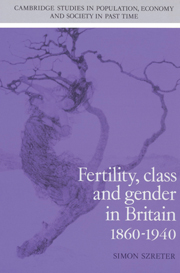Book contents
- Frontmatter
- Contents
- List of figures
- List of tables
- Acknowledgements
- List of abbreviations
- Introduction
- Part I Historiographical introduction: a genealogy of approaches
- Part II The professional model of social classes: an intellectual history
- Prologue: the fertility census of 1911 and the professional model of social classes
- 2 Social classification of occupations and the GRO in the nineteenth century
- 3 Social classification and nineteenth-century naturalistic social science
- 4 The emergence of a social explanation of class inequalities among environmentalists, 1901–1904
- 5 The emergence of the professional model as the official system of social classification, 1905–1928
- Part III A new analysis of the 1911 census occupational fertility data
- Part IV Conceptions and refutations
- Appendices
- Bibliography
- Index
- Cambridge Studies in Population, Economy and Society in the Past Time
3 - Social classification and nineteenth-century naturalistic social science
Published online by Cambridge University Press: 16 February 2010
- Frontmatter
- Contents
- List of figures
- List of tables
- Acknowledgements
- List of abbreviations
- Introduction
- Part I Historiographical introduction: a genealogy of approaches
- Part II The professional model of social classes: an intellectual history
- Prologue: the fertility census of 1911 and the professional model of social classes
- 2 Social classification of occupations and the GRO in the nineteenth century
- 3 Social classification and nineteenth-century naturalistic social science
- 4 The emergence of a social explanation of class inequalities among environmentalists, 1901–1904
- 5 The emergence of the professional model as the official system of social classification, 1905–1928
- Part III A new analysis of the 1911 census occupational fertility data
- Part IV Conceptions and refutations
- Appendices
- Bibliography
- Index
- Cambridge Studies in Population, Economy and Society in the Past Time
Summary
Introduction
Charles Booth's social survey methodology was to form the principal practical reference point for T. H. C. Stevenson when he came to consider the construction of a new official model of social classes for the 1911 census. As a result, Marshall's specific influence, conducted via Booth, was reflected in the linear skill gradings for the working classes which were to be adopted. But it was another social science product of the 1880s which was to provide the most fundamental conceptual influence – albeit through a dialectical process of political antagonism and intellectual critique.
This was the eugenic, or Galtonian, or meritocratic model of the nation's class structure. The model was first formalised within the empirical social sciences in the work of the Anthropometric Committee of the British Association for the Advancement of Science, completed in 1883. It is there fore to this ‘school’ of naturalistic social science that we now turn to discover the original investment of British empirical social science with the core political and moral ideals ensconced in the official, professional model of social structure.
The Anthropometric Committee's work was part of an attempt to interpret the observable phenomena of physiological and mental variation between individuals, social and ethnic groups in terms of the disputed insights of the Darwinist theory of evolution. It was also significantly motivated by the aspiration of contributing to the long-standing, ultimately theologically derived controversy over the origins of man's racial varieties: whether monogenist or polygenist.
- Type
- Chapter
- Information
- Fertility, Class and Gender in Britain, 1860–1940 , pp. 129 - 181Publisher: Cambridge University PressPrint publication year: 1996



